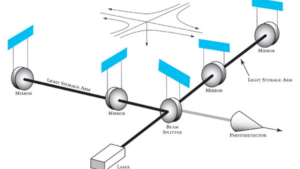Before reading, please listen to the clip below:
A normal observer would think of these sounds as a series of odd chirps, but for the scientists at LIGO (Laser Interferometer Gravitational-Wave Observatory), these sounds indicated something more significant. On 11 February 2016, the scientists working at LIGO announced to the world that they detected gravitational waves after months of analysing the signals they detected five months earlier. This discovery confirmed Einstein’s prediction of the presence of gravitational waves that he made over 100 years ago, which is a very significant contribution towards our understanding of the universe. For this great discovery, the renowned physicists Rainer Weiss, Barry Barish and Kip Thorne were jointly awarded the 2017 Nobel Prize in Physics (named in order of pictures from left to right).
News about gravitational waves has been circulating for a long time, but many people ask, what are gravitational waves? They are waves which originate from interactions between very large masses such as the merger of two black holes and travel in a vacuum. A simplified way of thinking about them is that they are waves that stretch and compress masses in space. This principle was used by Rainer Weiss in 1967 to demonstrate how laser interferometers can possibly be used to detect gravitational waves, should they exist. This important contribution led Rainer Weiss to receive half of the prize money awarded for the Nobel Prize in Physics, with Barry Barish and Kip Thorne each receiving a quarter of the prize money.
A simplified diagram of the LIGO interferometer is shown below. In normal conditions, the two light beams shown in the diagram reflect off the mirrors and meet at the same time at the photodetector and so cancel each other out. When a gravitational wave passes, the two light beams arrive at different times due to the distortion caused by gravitational waves. However, this distortion is extremely small, in the order of 10-18 m. To put this into perspective, the width of a hydrogen nucleus is 10-15 m and so it is an incredible technological feat for us to develop a way to measure such a minuscule distance.

Although they received lower portions of the prize money, Kip Thorne and Barry Barish made significant contributions towards this discovery. Kip Thorne initiated efforts to detect gravitational waves and co-founded the LIGO project, while Barry Barish was a director of the LIGO project and under his leadership, there were major developments in the LIGO project.
So what’s next after the detection of gravitational waves?
Well, gravitational waves offer us a different way to make observations about space. They can help us detect black hole mergers or supernovae, and mergers of neutron stars. Perhaps we can have a better understanding of the history of our universe and possibly locate positions of black holes. There are many mysteries in the world of astrophysics and gravitational waves could be an important tool used to uncover these mysteries.


